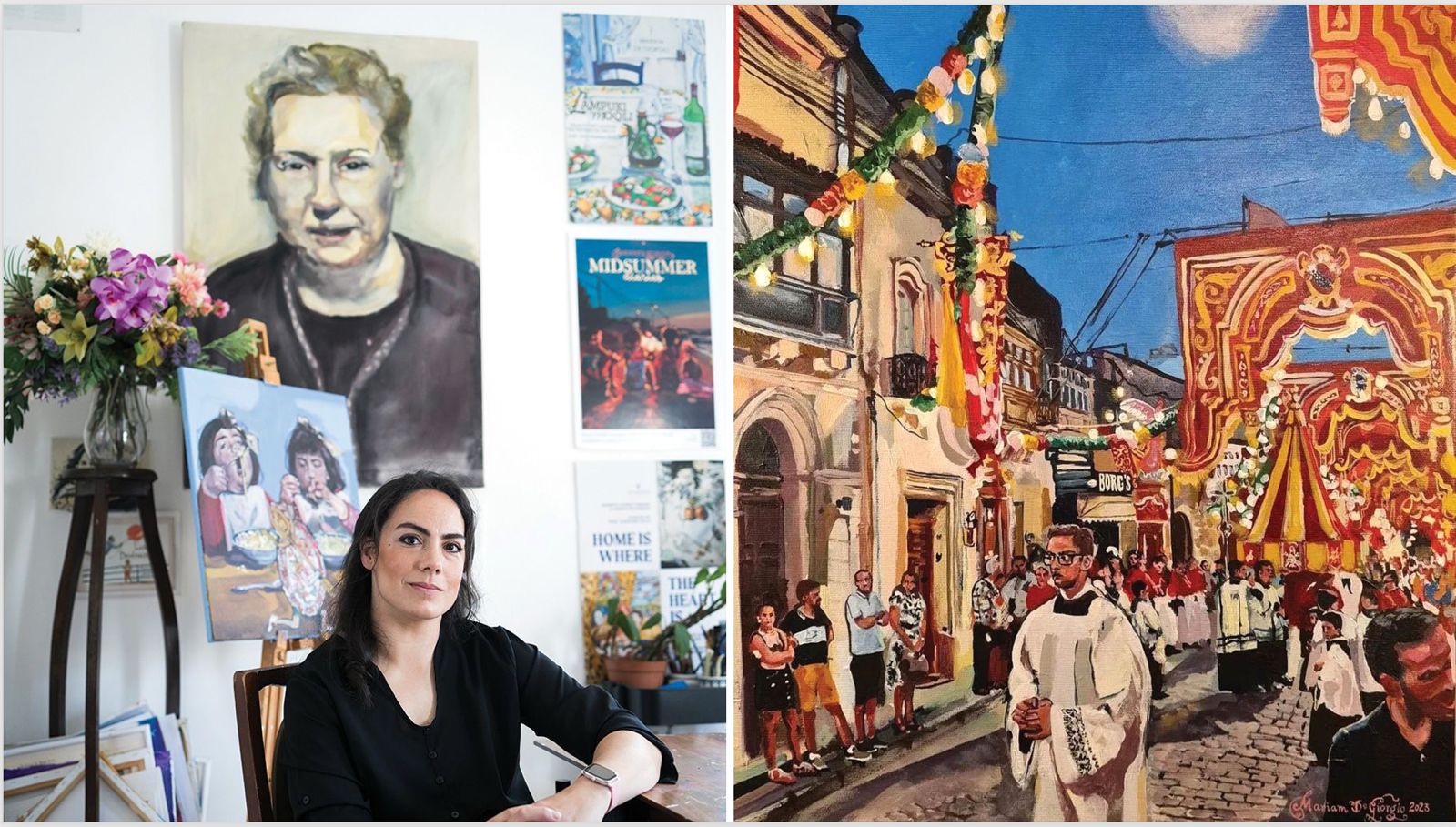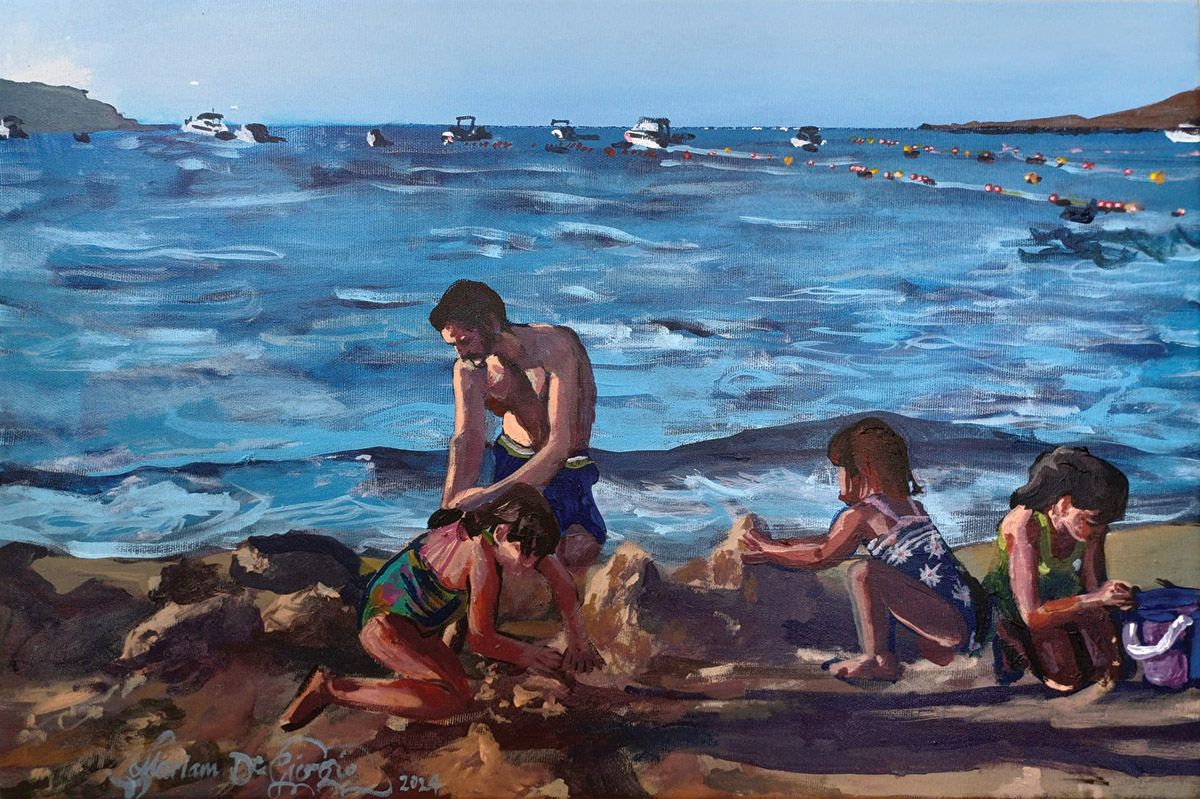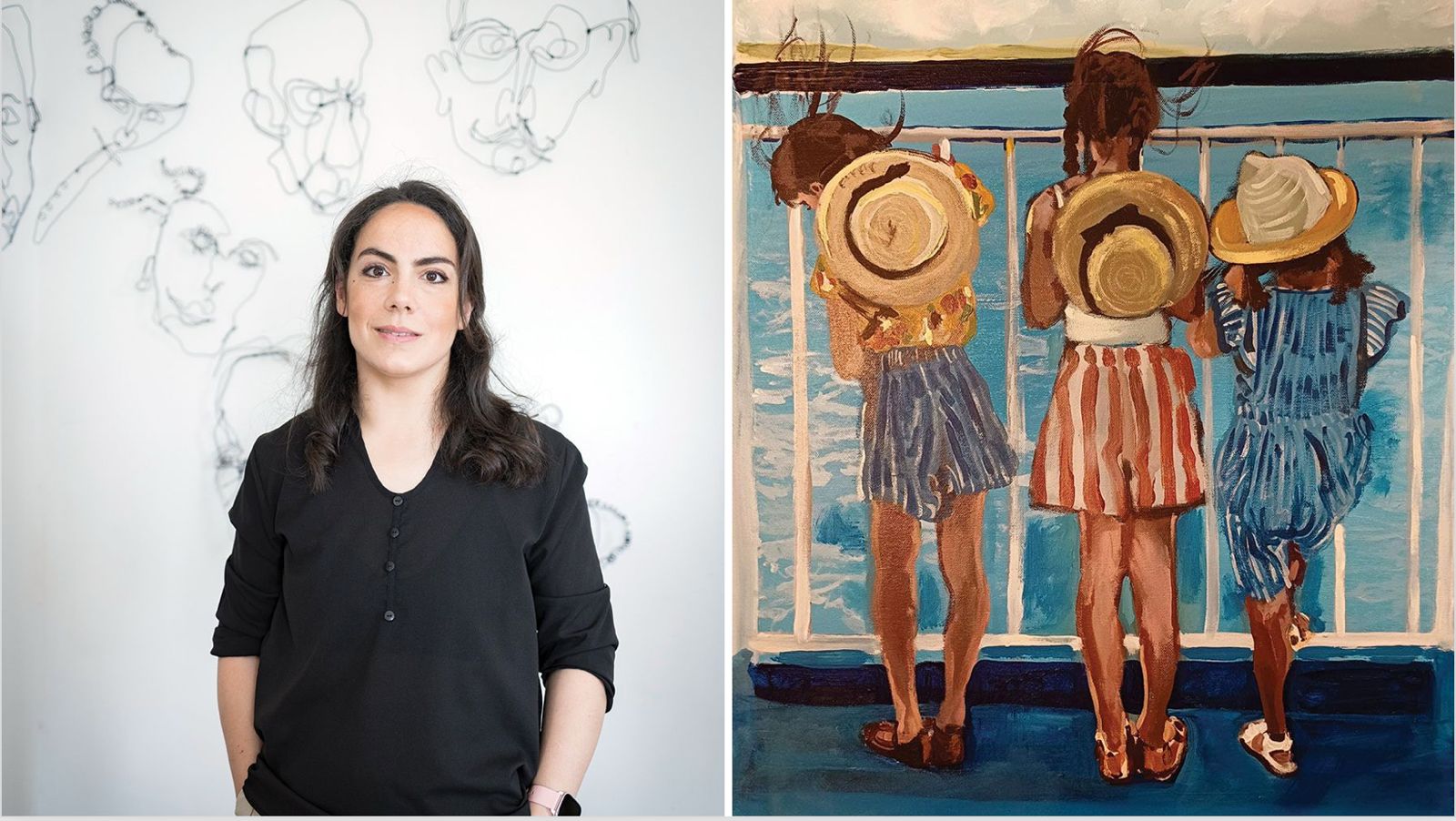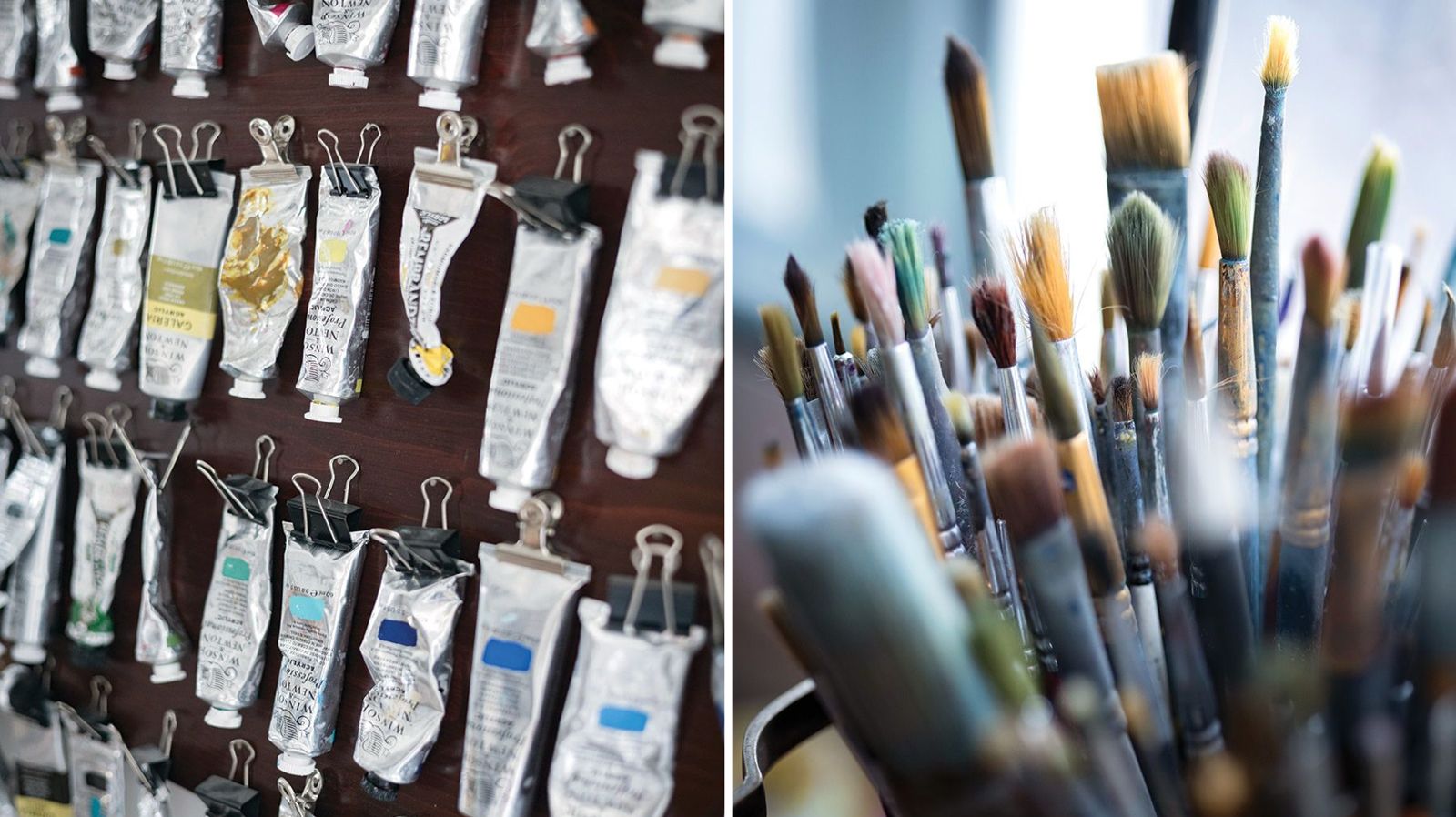Sam Vassallo meets the Maltese painter to unravel the layers of her work, where life and art intertwine in strokes of muted brilliance
In her sunlit studio in Birkirkara, artist Mariam de Giorgio transforms the ordinary into the extraordinary – capturing fleeting childhood moments, chaotic kitchens and quiet family rituals with a brush dipped in memory and nostalgia.
As I stepped into Mariam de Giorgio’s studio in Birkirkara, what struck me first was the sense that her work contained as many layers of meaning as paint. The air smelled of linseed oil and beeswax, with shafts of Maltese sunlight cutting through the dust motes to land on canvases propped against the walls – some finished, others half-born, their surfaces alive with the quiet drama of domestic life. A child’s foot dangling off a sofa. A kitchen counter cluttered with flour-dusted fish and cherry tomatoes. A sun-bleached rooftop where the family gathered on one particular Easter Sunday, the world still blissfully unaware of the pandemic looming on the horizon. Her palette is striking yet muted, colours softened as if by memory: the faded blue of a school uniform, the warm ochre of an old house’s walls, the blush-pink of a seashell cradled in a child’s palm.

Mariam greets me with the warmth of someone who has learned to balance the demands of art and motherhood – five children, a husband deep in his PhD studies and a home that hums with creative entropy. Her studio, a converted room upstairs, is a sanctuary of controlled chaos. Sketches spill from drawers, tubes of paint huddle like soldiers on a windowsill, and a large wooden desk bears the scars of a thousand brushstrokes. “This is where the magic happens,” she says with a laugh, nudging aside a stack of illustrated children’s books – a nod to her academic focus on Fine Arts. As we settle in, I understand quickly that her art is more than a surface-level depiction of domesticity. It is a meditation on time, memory and the fleeting innocence of childhood – a theme that pulses through our conversation like a second heartbeat.
“I’m inspired by the mundane,” Mariam admits, cradling a cup of coffee between her hands. The steam curls around her fingers, dotted with flecks of dried paint – tiny badges of her trade. “The daily things we overlook – like brushing teeth before bed, a child collapsing onto the sofa after school, spaghetti stains on a dinner plate – those are what fascinate me.” She gestures to a nearby painting, a snapshot of her daughter asleep mid-afternoon, socks discarded, backpack abandoned in a heap. The composition is effortless, the light catching the curve of the girl’s cheek, the rumpled fabric of her school dress. “That was the perfect shot. It’s not posed. It’s life, stolen before it slips away,” she muses.

Her process is organic, almost accidental. She documents moments with her phone, a tool as vital as her brushes. “I don’t always intend to paint what I capture,” she explains. “But when I look back, I see a story waiting to be told.” The stories are intimate: a family’s move from their grandmother’s house to their own, the evolution of a living room sofa over a decade, the quiet rituals of bedtime that frayed at the edges as the children grew. Her work feels like flipping through a diary, one where the entries were painted in strokes that blurred the line between realism and dream. A still life of a lampuka fish (a local delicacy) mid-preparation, dusted with flour and surrounded by capers, became a portrait of familial love. “The viewer can imagine the hands that cooked it, the voices around the table,” she says. “That’s what I want – to pull people into the life of the painting.”
Mariam’s fascination with childhood is palpable. “My work portrays the child in me,” she says, her voice softening. “I crave that innocence, that joy in discovery.” Her own childhood was unconventional. Raised in a devout Catholic family, she spent her early years in the Philippines as part of her parents’ missionary work. “It was a world of seashells and unfamiliar skies,” she recalls. “I remember the heat, the colours, the way the light hit the water differently there. I think that’s why I’m drawn to the extraordinary in the ordinary.”
Now, as a mother, she revisits that wonder through her children. “They’re my vessel,” she muses, pulling out a sketchbook filled with quick studies of her kids drawing, eating, sleeping, their limbs tangled in unselfconscious grace. “They do things like play with their fingers, laugh at nothing and I think, ‘I used to do that’. But now I see it differently. They’re teaching me to appreciate moments I once took for granted.” Her paintings capture this duality: the child’s unselfconscious joy and the adult’s nostalgic lens. A portrait of her son eating spaghetti, his face smeared with sauce, is more than a cute scene; it’s a meditation on time’s passage. “One day, he’ll be grown, and I’ll have this,” she says, touching the canvas lightly. “That’s the gift of painting – it’s a way to hold onto what refuses to stay still.”

Though her work is rooted in realism, whimsy seeps in at the edges. A teacup might float mid-air; a family barbecue in Comino, the sea glittering behind them, bent into a dreamlike haze as if viewed through heatwaves. She cites influences like René Cloque, the illustrator of Enid Blyton’s stories, and Matisse, whose playful interiors resonate with her. “I love surrealism,” she admits.
The result is tactile, alive. Her signature – a bold, calligraphic flourish – often appear in contrasting colours, a nod to her love of typography. “I mimicked typewriter fonts as a girl,” she laughs, showing me a wedding invitation she’d designed with looping, vintage-inspired script. “Now my handwriting looks like one. Funny how these things stick.”
Mariam’s creative process is anything but rigid. “I’m my own boss,” she says with a shrug. “Some days, I’m too tired to paint. Other days, I work until 2am.” She thrives under pressure, recalling her solo exhibition Midsummer last September, where she produced 30 works in a month. “Four paintings in a day!” she exclaims, shaking her head. “It was like a factory. But deadlines force me to focus.” She describes the adrenaline of last-minute commissions – like the time a client begged for a gift portrait in four days. “I said yes, even though I knew I’d be sleepless. There’s something about the panic that sharpens me.”
Commissions, however, are a double-edged sword. “People want portraits – children, usually. But I refuse flat, posed things.” She prefers candid scenes: kids from the back, watching the sea; a messy kitchen alive with movement. “I need to feel a connection. Otherwise, it’s just… depressing.” She pauses, then adds with a wry smile, “though I’ll admit, I sneak in my own style. A pop of unexpected colour, a hidden detail. It’s my little rebellion.”
As we wander through her home – past her sunlit studio where her bird chirps in its cage, a cluttered “mess-allowed” room for the kids (“They’re banned from paints, though – too stressful!”), and a hallway lined with exhibition posters – reveals how deeply her art and life intertwine. Her paintings are not just observations; they are conversations with time. A hotel in Comino stood untouched in one painting, then vanished in the next, replaced by construction cranes. “It’s all about life-changing situations,” she says. Even her thesis work – a study of Alice in Wonderland’s Mad Hatter’s tea party reimagined across artistic eras – speaks to her fascination with shifting perspectives.

Now, Mariam is preparing for her next show – a group exhibition titled A Sense of Place, curated by art historian Charlene Vella at The Phoenicia.
Before I leave, she shows me one last piece: a collage-painting framed in her kitchen, a whimsical nod to parenthood’s chaos. “This was me years ago,” she says, pointing to a frazzled figure in a cluttered kitchen. “A mother, overwhelmed. But look – here’s beauty in the mess.” And that, perhaps, is the heart of her work. In Mariam de Giorgio’s world, the mundane is monumental, childhood is a language, and every brushstroke is a whisper: Look closer. This is life.
This article first appeared on Guide Me 2025.
Photo credits: Inigo Taylor